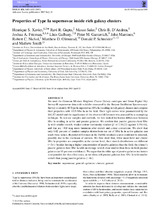| dc.contributor.author | Xavier, Henrique S. | |
| dc.contributor.author | Gupta, Ravi R. | |
| dc.contributor.author | Smith, Mathew | |
| dc.contributor.author | Sako, Masao | |
| dc.contributor.author | D’Andrea, Chris B. | |
| dc.contributor.author | Frieman, Joshua A. | |
| dc.contributor.author | Galbany, Lluis | |
| dc.contributor.author | Garnavich, Peter M. | |
| dc.contributor.author | Marriner, John | |
| dc.contributor.author | Nichol, Robert C. | |
| dc.contributor.author | Olmstead, Matthew D. | |
| dc.contributor.author | Schneider, Donald P. | |
| dc.date.accessioned | 2017-07-26T07:54:11Z | |
| dc.date.available | 2017-07-26T07:54:11Z | |
| dc.date.issued | 2013 | |
| dc.identifier.citation | Xavier, H. S. et al. (2013). Properties of Type Ia supernovae inside rich galaxy clusters. Monthly Notices of the Royal Astronomical Society, 434: 1443–1459 | en_US |
| dc.identifier.issn | 0035-8711 | |
| dc.identifier.uri | http://hdl.handle.net/10566/3111 | |
| dc.description.abstract | We used the Gaussian Mixture Brightest Cluster Galaxy catalogue and Sloan Digital Sky
Survey-II supernovae data with redshifts measured by the Baryon Oscillation Spectroscopic
Survey to identify 48 Type Ia supernovae (SNe Ia) residing in rich galaxy clusters and compare
their properties with 1015 SNe Ia in the field. Their light curves were parametrized by the
SALT2 model and the significance of the observed differences was assessed by a resampling
technique. To test our samples and methods, we first looked for known differences between
SNe Ia residing in active and passive galaxies. We confirm that passive galaxies host SNe
Ia with smaller stretch, weaker colour–luminosity relation [β of 2.54(22) against 3.35(14)],
and that are ∼0.1 mag more luminous after stretch and colour corrections. We show that
only 0.02 per cent of random samples drawn from our set of SNe Ia in active galaxies can
reach these values. Reported differences in the Hubble residuals scatter could not be detected,
possibly due to the exclusion of outliers. We then show that, while most field and cluster
SNe Ia properties are compatible at the current level, their stretch distributions are different
(∼3σ): besides having a higher concentration of passive galaxies than the field, the cluster’s
passive galaxies host SNe Ia with an average stretch even smaller than those in field passive
galaxies (at 95 per cent confidence).We argue that the older age of passive galaxies in clusters
is responsible for this effect since, as we show, old passive galaxies host SNe Ia with smaller
stretch than young passive galaxies (∼4σ). | en_US |
| dc.language.iso | en | en_US |
| dc.publisher | Oxford University Press | en_US |
| dc.rights | Copyright the Authors. Authors may archive the published version in their institutional repository. | |
| dc.source.uri | http://dx.doi.org/10.1093/mnras/stt1100 | |
| dc.subject | Supernovae | en_US |
| dc.subject | General – galaxies | en_US |
| dc.subject | Clusters | en_US |
| dc.subject | General | en_US |
| dc.title | Properties of Type Ia supernovae inside rich galaxy clusters | en_US |
| dc.type | Article | en_US |
| dc.description.accreditation | Web of Science | |

